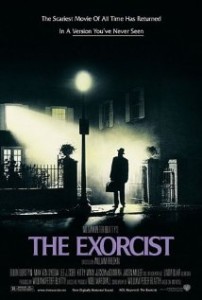Horror is the reason for Christmas.
“The Exorcist,” by all survey accounts, is still ranked as the scariest movie of all time. A head-spinning, vomit-spewing, profanity-cursing, demonic-sounding 12 year old girl still leaves most film watchers retching in their seats.
Terry Mattingly’s interview with Blatty [1] explains why we should be retching in our souls.
The original novel from which the movie was made gives the author’s purpose. The key to understanding “The Exorcist,” Blatty contends, is understanding the old priest who will perform the exorcism. The priest, Father Damien Karras, is the ultimate target of the devil’s attack. “The Devil is tempting him to despair, to doubt his own humanity,” as Blatty cites a centerpiece quote of the novel’s vision:
“I think the point is to make us . . . see ourselves as ultimately bestial, vile and putrescent; without dignity; ugly; unworthy. And there lies the heart of it, perhaps. . . . For I think belief in God is not a matter of reason at all; I think it finally is a matter of love: of accepting the possibility that God could ever love us.”
Father Karras doubts the reality of demons, but he doubts more the reality of God’s love for sinners, including himself. Karras is not just a priest, but a Jesuit psychiatrist. The Father’s own psychoses are being tested as he grieves for his own mother’s death. Just like the priest, Blatty was working on “The Exorcist” screenplay when he received a phone call that his mother had just died. Blatty immediately made the connection:
“I knew what I wanted to do. I wanted to make a statement that the grave is not the end, that there is more to life than death.”
Blatty’s extensive research into exorcism convinced him the movie could compel people to see “that the spiritual world is real.” Demon possession, Blatty concluded, should drive moviegoers to confession.
“My logic was simple: If demons are real, why not angels? If angels are real, why not souls? And if souls are real, what about your own soul?”
After reading Mattingly’s interview, I immediately thought of John’s words
The reason the Son of God appeared was to destroy the works of the devil (1 John 3.8)
The devil tried to beat Jesus to the punch. Herod was following the devil’s plan to kill Jesus (Matthew 2). Herod sent his henchmen to do the devil’s work but God’s plan will never be thwarted. As Martin Luther wrote
For still our ancient foe, doth seek to work us woe;
his craft and power are great, and armed with cruel hate, on earth is not his equal.
Did we in our own strength confide, our striving would be losing,
were not the right man on our side, the man of God’s own choosing.
Dost ask who that may be? Christ Jesus, it is He
Blatty’s screenplay “The Exorcist” represents the devil’s battle for human souls and his ultimate defeat, at the feet, of Jesus.
Blatty’s vision for “The Exorcist” screenplay is embedded in the gospel message. “The Exorcist” reverberates through hymn lines like “But still our ancient foe, dost seek to work us woe.” “The Exorcist” points us back to Jesus.
The horror of “The Exorcist” is the reason for Christmas.
________________________________________________________________
Mark watched “The Exorcist” once: fast-forwarding, with the sound off. But Mark knows that to acknowledge demons is to acknowledge angels, redemption, and The Cross best represented by Colossians 2:15. Dr. Mark Eckel draws students’ attention to our final destination to remind us of our present decision: what will we do with Jesus.
[1] My quotes, allusions, comments about and from William Peter Blatty are fully dependent on Mattingly’s interview cited here by hyperlink.


I love how you often use hymns to stress your “point”! Words are also your “tools”!!
I am grateful for your gracious, generous words!